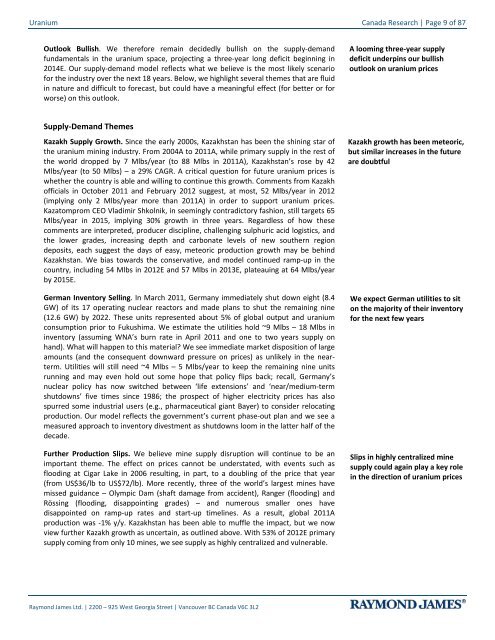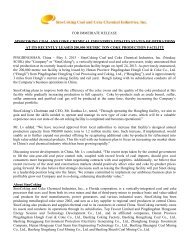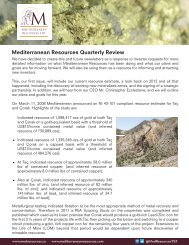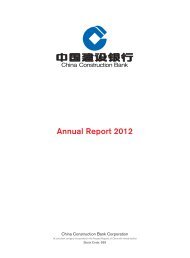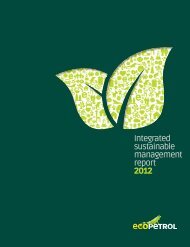Clock - Uranium Supply Crunch and Critical ... - Andrew Johns
Clock - Uranium Supply Crunch and Critical ... - Andrew Johns
Clock - Uranium Supply Crunch and Critical ... - Andrew Johns
- No tags were found...
Create successful ePaper yourself
Turn your PDF publications into a flip-book with our unique Google optimized e-Paper software.
<strong>Uranium</strong> Canada Research | Page 9 of 87Outlook Bullish. We therefore remain decidedly bullish on the supply-dem<strong>and</strong>fundamentals in the uranium space, projecting a three-year long deficit beginning in2014E. Our supply-dem<strong>and</strong> model reflects what we believe is the most likely scenariofor the industry over the next 18 years. Below, we highlight several themes that are fluidin nature <strong>and</strong> difficult to forecast, but could have a meaningful effect (for better or forworse) on this outlook.A looming three-year supplydeficit underpins our bullishoutlook on uranium prices<strong>Supply</strong>-Dem<strong>and</strong> ThemesKazakh <strong>Supply</strong> Growth. Since the early 2000s, Kazakhstan has been the shining star ofthe uranium mining industry. From 2004A to 2011A, while primary supply in the rest ofthe world dropped by 7 Mlbs/year (to 88 Mlbs in 2011A), Kazakhstan’s rose by 42Mlbs/year (to 50 Mlbs) – a 29% CAGR. A critical question for future uranium prices iswhether the country is able <strong>and</strong> willing to continue this growth. Comments from Kazakhofficials in October 2011 <strong>and</strong> February 2012 suggest, at most, 52 Mlbs/year in 2012(implying only 2 Mlbs/year more than 2011A) in order to support uranium prices.Kazatomprom CEO Vladimir Shkolnik, in seemingly contradictory fashion, still targets 65Mlbs/year in 2015, implying 30% growth in three years. Regardless of how thesecomments are interpreted, producer discipline, challenging sulphuric acid logistics, <strong>and</strong>the lower grades, increasing depth <strong>and</strong> carbonate levels of new southern regiondeposits, each suggest the days of easy, meteoric production growth may be behindKazakhstan. We bias towards the conservative, <strong>and</strong> model continued ramp-up in thecountry, including 54 Mlbs in 2012E <strong>and</strong> 57 Mlbs in 2013E, plateauing at 64 Mlbs/yearby 2015E.German Inventory Selling. In March 2011, Germany immediately shut down eight (8.4GW) of its 17 operating nuclear reactors <strong>and</strong> made plans to shut the remaining nine(12.6 GW) by 2022. These units represented about 5% of global output <strong>and</strong> uraniumconsumption prior to Fukushima. We estimate the utilities hold ~9 Mlbs – 18 Mlbs ininventory (assuming WNA’s burn rate in April 2011 <strong>and</strong> one to two years supply onh<strong>and</strong>). What will happen to this material? We see immediate market disposition of largeamounts (<strong>and</strong> the consequent downward pressure on prices) as unlikely in the nearterm.Utilities will still need ~4 Mlbs – 5 Mlbs/year to keep the remaining nine unitsrunning <strong>and</strong> may even hold out some hope that policy flips back; recall, Germany’snuclear policy has now switched between ‘life extensions’ <strong>and</strong> ‘near/medium-termshutdowns’ five times since 1986; the prospect of higher electricity prices has alsospurred some industrial users (e.g., pharmaceutical giant Bayer) to consider relocatingproduction. Our model reflects the government’s current phase-out plan <strong>and</strong> we see ameasured approach to inventory divestment as shutdowns loom in the latter half of thedecade.Further Production Slips. We believe mine supply disruption will continue to be animportant theme. The effect on prices cannot be understated, with events such asflooding at Cigar Lake in 2006 resulting, in part, to a doubling of the price that year(from US$36/lb to US$72/lb). More recently, three of the world’s largest mines havemissed guidance – Olympic Dam (shaft damage from accident), Ranger (flooding) <strong>and</strong>Rössing (flooding, disappointing grades) – <strong>and</strong> numerous smaller ones havedisappointed on ramp-up rates <strong>and</strong> start-up timelines. As a result, global 2011Aproduction was -1% y/y. Kazakhstan has been able to muffle the impact, but we nowview further Kazakh growth as uncertain, as outlined above. With 53% of 2012E primarysupply coming from only 10 mines, we see supply as highly centralized <strong>and</strong> vulnerable.Kazakh growth has been meteoric,but similar increases in the futureare doubtfulWe expect German utilities to siton the majority of their inventoryfor the next few yearsSlips in highly centralized minesupply could again play a key rolein the direction of uranium pricesRaymond James Ltd. | 2200 – 925 West Georgia Street | Vancouver BC Canada V6C 3L2


